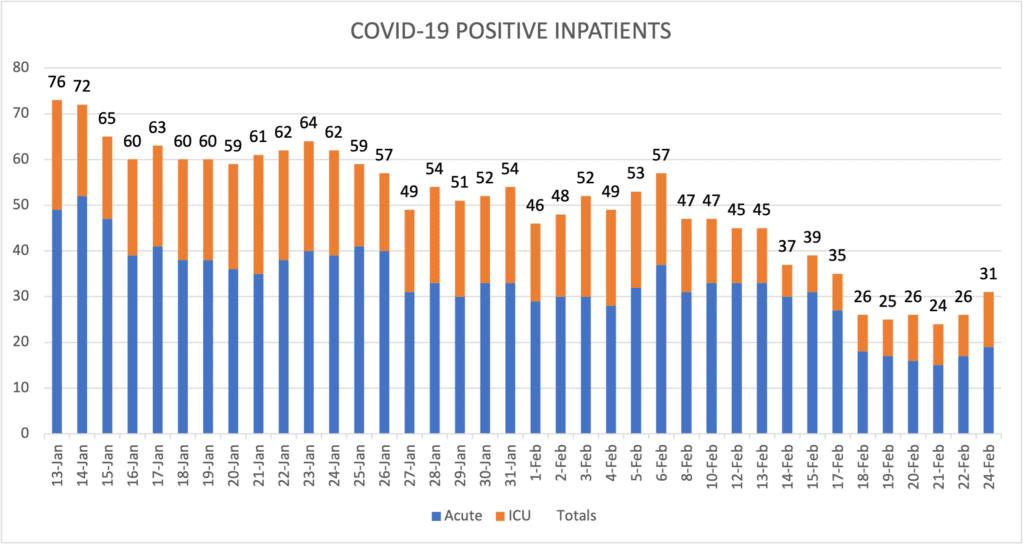Data Snapshot
UW Medicine Hospitals:

King County: The county reported 261 new positive cases and 8 new deaths on Feb. 25.
Washington: The state reported 318,510 cases and 4,912 deaths as of Feb. 23.
United States: The CDC reports 28,065,327 cases and 501,181 deaths as of Feb. 24.
Global: WHO reports 112,209,815 confirmed COVID-19 cases and 2,490,776 deaths as of Feb. 25.
Numbers update frequently, please follow links for most up-to-date numbers.
UW Medicine COVID-19 Vaccine Distribution Update
Total Vaccine Doses Administered: 93,521
- Total first dose: 60,105
- Total second dose: 33,416
As of Feb. 23, 2021.
UW Medicine in the News
CNN: Experts worry variant-fueled surge of Covid-19 could be weeks away but cases will likely fall again by summer
Featuring: Trevor Bedford, Genome Sciences
“Coronavirus infections across the US are still on the way down, and more Americans are getting vaccinated — but variants could cause complications soon. Several experts predicted the highly contagious B.1.1.7 variant first detected in the UK is likely to fuel another surge of cases in just a matter of weeks. ‘It could result in more of a wave in, say, April or May than we would have expected otherwise,’ Trevor Bedford, of the University of Washington and the Fred Hutchinson Cancer Research Center, said during a briefing sponsored by the center on Tuesday. ‘But I still do suspect that things will be brought under control in the summer, and there will be very little virus circulating.’”
KING 5: Snohomish schools partner with UW for COVID-19 testing and tracing
Featuring: Helen Chu, Allergy & Infectious Diseases
“Like other school districts, Snohomish schools have implemented new hygiene, social distancing and ventilation protocols for the small number of students who have returned to class. But those only go so far. With that in mind, for the first time, all of the district’s elementary schools are partnering with University of Washington researchers to see if there are better ways to make schools safer from COVID-19 outbreaks.”
The Seattle Times: An uncertain future for millions of COVID-19 long haulers – and for society
Featuring: Nicholas Franko and Jenni Logue, Chu Lab, Division of Allergy and Infectious Disease
“‘Have you had any of the following symptoms: fatigue, loss of sense of taste and smell, muscle and body aches, shortness of breath?’ In the last year, I’ve asked about these symptoms more times than I can count. We think of them as the passing effects of an illness, an unfortunate nuisance that disappears as the illness is cleared and we return to our normal state of health. However, for some people with COVID-19, the usually temporary symptoms linger long past the initial illness. To better understand who is developing prolonged symptoms and which symptoms are most likely to persist, colleague Jenni Logue and I studied a group of people who had recovered from COVID-19 several months prior. We examined a group of Seattle-area individuals who had tested positive months earlier for COVID-19, asking whether they still experienced effects of their illness. Surprisingly, 30% of participants reported at least one symptom at an average of six months after their acute infection. Participants’ infections spanned ‘mild,’ ‘moderate’ and ‘severe’ designations. Of note, 84% of the participants had a mild infection and 64% did not even seek medical care. With an average age of 48, our cohort was generally young and healthy. Yet 30% of those with mild illness reported a worse quality of life after they had recovered from the acute phase of infection. We are starting to see the infections’ lasting, negative effects on the daily lives of those affected. Looking more broadly, there are large potential ramifications for local and national economies and health care systems.”
COVID-19 Literature Report
COVID-19 Literature Situation Report is a daily (M-F) newsletter put together by the Alliance for Pandemic Preparedness that provides a succinct summary of the latest scientific literature related to the COVID-19 pandemic.
Key Takeaways: COVID-19 Literature Situation Report Feb. 24, 2021
- The Johnson and Johnson one-dose SARS-CoV-2 vaccine candidate Ad26.COV2.S was determined by the FDA to have met requirements for emergency use authorization. The vaccine efficacy against moderate to severe COVID- was 66.9% when considering cases occurring at least 14 days after vaccination, and 66.1% considering cases occurring at least 28 days after vaccination. Efficacy against severe/critical COVID-19 occurring at least 14 days and at least 28 days after vaccination was 76.7% and 85.4%, respectively. More.
- A large outbreak of COVID-19 occurred among attendees of indoor high-intensity fitness classes at a Chicago exercise facility in August, 2020, with 55 cases identified among 81 attendees (68% attack rate). Classes were held at reduced capacity (<25%) and participants were required to space mats at least 6 feet apart. Most attendees wore masks infrequently (79%). More.
- An outbreak of COVID-19 cases occurred that was linked to a fitness instructor resulting in cases at 3 fitness facilities. The highest attack rate (95%) occurred in classes that were taught <1 day before the onset of symptoms in the instructor. More.
- In a sample of 118 participants recruited from clinical trials at a single center in the United States, 82% of hospitalized patients and 64% of non-hospitalized patients had persistent symptoms 3-4 months after COVID-19 diagnosis. The most prevalent symptoms included fatigue and difficulty breathing (dyspnea). More.
COVID-19 Literature Surveillance Team, is an affiliated group of medical students, PhDs and physicians keeping up with the latest research on SARS-CoV-2 / COVID-19 by finding the newest articles, reading them, grading their level of evidence and bringing you the bottom line.
Read the latest report: Feb. 24 | Daily COVID-19 LST Report.
Listen to the latest podcast: Week of Feb. 15 | COVID-19 LST Podcast.
Tweet of the Week
When will those receiving positive results from a COVID-19 test learn if they are infected with a variant? @GreningerLab @UWVirology anticipates a federally authorized test for coronavirus whole-genome sequencing in a few weeks. @inforum https://t.co/5myJ9H1XgE
— UW Medicine Newsroom (@uwmnewsroom) February 25, 2021

